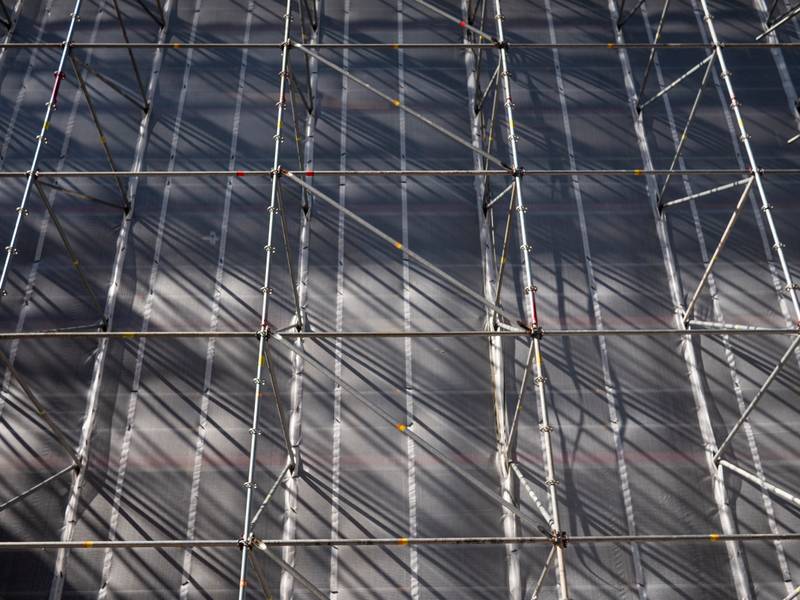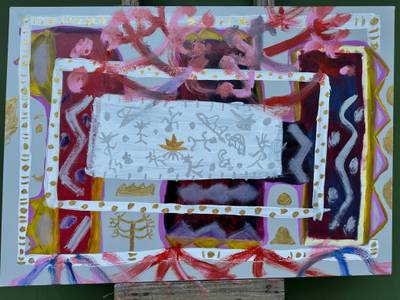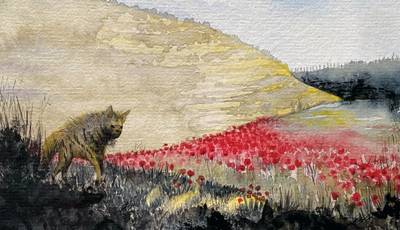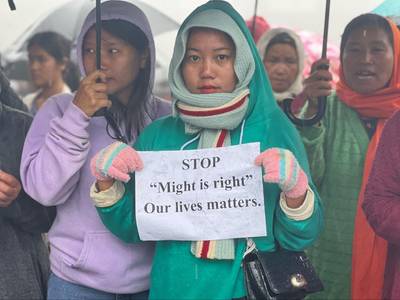

Kiasma museum in Helsinki will open anew 2022 after extensive renovations
Pietari Kylmälä keeps a garden. He works at Finnish National Broadcasting Company YLE as a journalist, specialising in literary reviews. Their upcoming podcast series Lukupiiri Tulusto & Kylmälä will discuss new books.
Eero Yli-Vakkuri is a recovering survivalist. In the past he made annoying street interventions which made people uncomfortable. Presently he is advancing sustainable design through campaigns and artistic presentations. He serves as the self appointed Speaking Clock of Finland.
Signing a petition was easy, let’s work together and take this further
Many in our age group in Finland, people who reached adulthood in the ’90s, grew up believing that global politics could be steered by becoming ethical consumers. We believed that it was possible to destroy multinational corporations, to counteract state-led hostilities and industries which made profits by exploiting natural resources, by boycotting their products and services. This led us to sincerely believe that by refusing to purchase fruits produced in the State of Israel, we could improve the lives of Palestinians living under oppression. By today’s standards, this belief appears naïve. In our defence, these efforts were fueled by previous generations’ success with the Anti-Apartheid Movement and boycotts, which were influential in putting an end to the oppressive South African regime. Boycott movements have been able to shed light on cultural, economic and political structures that support oppressive politics.
With this text, we hope to renew a sincere belief that united art workers can do good by calling for candid public discussion on difficult matters. We wish to make clear some of the political affiliations held by the Kiasma Support Foundation, especially in relation to the colonial politics by the State of Israel and hope that this text will open a dialogue with workers of the National Gallery, who despite prevailing uncertainty, remain motivated to better their organization. We hope that art administrators in Finland will usher forward programs, which manifest their political desires and illustrate how they imagine the institutions they lead serving the public.
Witnessing the international community’s unwillingness to take measures against the recent escalations of the aggression against the Palestinian people, is building up to cynicism. The current status quo has been made to appear remote and normalised, which is why it is shocking that there is a local, burning question which all art workers in Finland should ask: Why is a person who funds an influential pro-Israeli lobbying organization and who has a long record of investments in companies which work for the security and military forces of the State of Israel, serving as a member of the Kiasma Support Foundation?
As art workers who are interested in the politics that govern global decision-making processes, it is impossible to ignore the cultural and social impact that Israel’s occupation of Palestinian territories has had. The Palestinian call for reforms and Israel’s changing alliances, have mangled common understanding of what signifies “war”, what is an “occupation” and ultimately what is “peace”. The prolonged military occupation is blurring these definitions. But there is hope in clarifying blurred concepts and making a stance. Recently, the cultural biases on which the media industries of the global west have based their portrayal of Palestinians and their political leaders, have been called to question. And currently, light is being shed to reveal the colonialistic characteristics of the rule which the State of Israel holds over Palestinians.
Witnessing the international community’s unwillingness to take measures against the recent escalations of the aggression against the Palestinian people, is building up to cynicism. The current status quo has been made to appear remote and normalised, which is why it is shocking that there is a local, burning question which all art workers in Finland should ask: Why is a person who funds an influential pro-Israeli lobbying organization and who has a long record of investments in companies which work for the security and military forces of the State of Israel, serving as a member of the Kiasma Support Foundation?
Recent tragic events in Israeli-occupied territories have revealed exceptional complexity that we must first resolve through our relationship with the contemporary art museum Kiasma, the crown jewel of the Finnish National Gallery institution. To begin we need to ask: Is there a reason to be concerned about the secretive business person Chaim “Poju” Zabludowicz?
Mapping the reasons for the boycott
Boycott Divest Zabludowicz (BDZ) initiative started in the UK around 2014. BDZ aligns itself with the broader Boycott Divestment Sanctions (BDS) movement, which “works to end international support for Israel’s oppression of Palestinians and pressure Israel to comply with international law”. BDS is well known in Finland thanks to recent petitions which have gained around 400 signatories by artists, cultural workers and academics condemning Israel’s colonialism, occupation and violence against the Palestinian people. Members of the Boycott Divest Zabludowicz initiative have mapped out various businesses in which Zabludowicz is involved and their research has developed into a campaign that urges artists and art workers to refuse to sell their labour to the Zabludowicz Art Trust or its subsidiaries. The subsidiaries include Daata Art (online art space, which recently begun dealing NFTs), Times Square Space (a residency and venue in New York), the Zabludowicz Collection and Sarvisalo artist residency in Loviisa, Finland (which also serves as a family summer place, housing parts of the collection).
The BDZ campaign has been discussed in art journals including Mute magazine and White Pube. Hyperallergic has reported that over 600 artists and organizations have signed a letter supporting the campaign and Art Forum detailed recently that 25 artists had publicly disaffiliated their artworks from the Zabludowicz Collection, citing the same reason the campaign has brought forth. The BDZ campaign is adamant that a cultural strike is necessary. To support their case, BDZ and other outlets voicing concerns, refer to independent research conducted for a 2013 publication The Britain Israel Communications and Research Centre – Giving peace a chance?. The publication is authored by researchers from the University of Bath and published by the British media watchdog Spinwatch & MEMO. The report details how Zabludowicz came to wealth and investigates their current involvement in Israeli state politics.
To summarize, Zabludowicz is the chairman and CEO of Tamares Group, a global private investment group. Tamares was established by their father, who through their involvement in Soltam Ltd. made fortunes organizing arm trade between the Finnish arms manufacturing company Tampella and the State of Israel. Arms trade constituted Zabludowiczes close to Israeli political elites, such as politician Benjamin Netanyahu. In the early nineties the family began to take distance from arms trade. This shift coincides with the period when the Arab League’s boycott of the State of Israel began to wither which opened the country to investments from abroad. Currently a subsidiary of Tamares, Tamares Real Estate Investments manages and develops properties in Israel and around the globe. Tamares also holds investments in the food delivery company Wolt, Mustavaaran Kaivos and various high-tech companies.
Despite being distanced from arms trade, Tamares maintains ties with the security and military forces of the State of Israel. In 2017, Tamares became an investor in a U.S. software company Palantir. A report from the same year reveals that the company is contracted by Israeli security organisations, which use their services to analyse social media posts for the purpose of profiling and targeting Palestinians. Palantir has been criticised by Amnesty international in 2020 for human rights abuses against U.S. immigrants. Recently, Tamares sold their shares of Knafaim Holdings Ltd, a company focused on the aviation industry which provides “professional maintenance services to pilots in the Israel Air Force”. In the past the company has also been involved in property developments situated in illegal colonial settlements on occupied Palestinian land via British Israel Investments Ltd. In 2013 the investor sold its stake in military ammunition manufacturer Pocal Industries to Nammo AS, a company co-owned by the Finnish defence, security and aviation contractor Patria and the State of Norway.
Zabludowicz is the founding director and major donor of the Britain Israel Communications & Research Centre (BICOM), which is a non-profit organization based in the UK. The advocacy was formed in the early 2000s, after failures of the Camp David Summit led to the Palestinian uprising known as the Second Intifada. The State of Israel responded to the uprising with “Operation Defensive Shield” which led to the destruction of civilian settlements and dehumanising control measures targeting Palestinians. As news of the systematic violence which Israel Defence Forces conducted against civilians breached international news, politicians and citizens across the globe began to publicly voice their concerns. This led businesspersons in the UK, who were motivated to secure their investments in Israel, to launch public relations campaigns which sought to spin the event in favor of the State of Israel. BICOM and similar organizations were established in the wake of these events.
The aforementioned 2013 investigation on BICOM concludes that the organization aims to change public opinion, by influencing political leaders and that it is willing to present “even illegal actions by the Israeli state in a favourable light” to succeed in its efforts. The report argues that while the organization endorses a two state solution, the model it strives for “fails to meet standards of international law or restore Palestinian rights.” The investigation implies that BICOM is publicly in favour of a fair resolution to the Israel/Palestine conflict, but in actuality this is a façade which hides the organization’s agenda, which is to keep UK and other European authorities favorable to Israel’s policies – as this is beneficial for businesses which have invested in the country. Support for their assessment can be found in a text which Zabludowicz personally wrote in 2011, which offers insight to BICOMs motives:
We have learnt over the last 10 years, through the research work BICOM has undertaken, that the key to creating a more supportive environment for Israel in Britain is convincing people in this country that Israel seeks a lasting peace with its neighbours. As long as this argument remains credible then people will generally forgive mistakes and difficulties even if peace continues to be elusive. Clearly they accept a peace agreement is not in Israel’s gift alone.
As an example of the type advocacy which BICOM conducts, we recommend reading their report from 2014 titled The Apartheid Smear. The 64 page document aims to convince its readers, that Israel is not an apartheid state and that any such allegations are damaging to the peace process. The publication explains that efforts to call out similarities between the current actions of the Israeli State and the atrocities of South African apartheid, are extremist attempts to “demonise the State of Israel”. The writers argue that such allegations should not be taken serious as the “the Apartheid Smear” originated as a campaign operated by “totalitarian communist states during the Cold War”. As a textbook example on how words and concepts associated with progress get spinned for political aims, the publication depicts the eviction of Bedouin communities from their settlements as a “relocation” process which aims to “provide basic infrastructure” for a deprived community. The publication starts with a quote from Nelson Mandela, the anti-apartheid revolutionary and statesman who was vital in bringing an end to the South African apartheid – the very regime which Soltam supplied field guns for in 1976.
Based on this source, BICOM appears supportive of development processes which the State of Israel conducts in occupied territories. To gain a better understanding of how these processes affect people living in the area, we can turn to the work of the acclaimed Forensic Architecture agency. In an Al-Jazeera documentary, Architecture of Violence (2014), architect Eyal Weizman introduces architecture as a weapon which Israeli forces use for maintaining segregation and exercising control in Palestinian territories. Their analysis of the construction of illegal Israeli settlements in occupied territories are revealed as means of war which aim to drive out Palestinians and to normalize Israeli presence in occupied land.


Soft power, hard impact
Soft power, hard impact
Locally in Finland, efforts to investigate Zabludowicz’s involvement in culture politics were launched by acclaimed critic Otso Kantokorpi, who before his passing wrote an article titled “Powerplay and Blood Art” (Vallankäyttöä ja veritaidetta, 2016) for Kansan Uutiset. The article focuses on an exhibition titled Zabludowicz Collection organized in Taidehalli (Kunsthalle) located in Helsinki. The article summarises the same concerns we have recapped here and builds its case using many of the same references. In addition Kantokorpi did his best to map out various political ties which Zabludowicz maintains in Finland. As an example, former Prime Minister Alexander Stubb, from the liberal concervative National Coalition Party, is mentioned as receiving considerable campaign donations from them.
The exhibition at Taidehalli offers a fitting backdrop to assess what an investor has to gain through their involvement in contemporary art. Taidehalli has a long history in presenting collections and exhibitions which reflect global politics. Through her research former Taidehalli director and researcher Maija Koskinen has provided tools for understanding what “soft power” is and why it is very dangerous not to take its effects seriously. Koskien argues that art, as a process open for interpretation, offers a fitting platform for political and ideological influencing. Throughout its history, Helsinki Taidehalli has hosted exhibitions that have promoted their organizers’ political goals, from blatant propaganda brought in by Germany in ’30s and the Soviet Union after the Second World War to subtle avant-garde art exhibitions through which the United States tried to win its “battle for hearts and minds’’. The rapidly changing alliances of Finnish State politics during the 20th century have accustomed local art institutions to serve as unopinionated stages showcasing the ideologies of different states and régimes. Crudely, it seems to us, this has led to a self-deceiting institutional understanding of an exhibition merely as a platform detached from the political content on display.
To simplify, soft power is a definition for various subtle methods that are used to affect public opinion. It is at work when venture capitalists become viewed as philanthropists and it may also be used to normalize violent and harmful power structures. Art collections are powerful: Collectors manifest their worldviews with their possessions. The Hyperallergic article mentioned earlier offers a quote from a spokesperson of the Zabludowicz Collection who responds to the BDZ campaign by insisting that the “Zabludowicz Collection is not a political organisation”. The author of the article, Valentina Di Liscia continues by asking: How does this statement present the work of voiceful artists in the collection such as Yael Bartana, Glenn Ligon and Francis Alÿs (among others)? How does the statement affect artworks which seek to expose the inner workings of present-day political violence? In effect, it seems that “art-washing” seeks to cleanse artworks from their ability to speak truth to power.
Otso Kantokorpi concluded their article in Kansan uutiset by announcing that they would not attend the Zabludowicz Collection exhibition at Taidehalli. Kantokorpi’s critique realized that an art exhibition is not a neutral event. Being spotted at Zabludowicz’s yacht at the Venice Biennial can be a career highlight for aspiring business persons and artists alike. And investing attention to an exhibition will strengthen its impact and further its political agenda, regardless of how unpronounced it may be.
Stagnating public funding has made art institutions willing to source funds from parties whose intentions remain clouded. In practice the funds which directors and managers succeed in securing for their organizations, form a prime component of their reputations and establish their future careers. Unfortunately, this has opened public institutions to influencers, whose sources of wealth and motivations are difficult to investigate.
How should we feel about Kiasma?
The Kiasma Support Foundation is a private organization that was established to source private funding to maintain a public institution. Its core consists of businesspeople who are willing to support the Kiasma art museum financially and lend their network of public relations in favor of it. The organization has had substantial influence in museums exhibition policy in bestowing pieces of art and enabling exhibitions. Zabludowicz became involved with Kiasma in 2009 as an early member of the support foundation.
Kiasma’s current staff “inherited” the Support Foundation from former director Berndt Arell, whose administration coincided with a difficult phase for Finnish art organizations. At the time, a proposal to establish a Guggenheim museum in Helsinki caused conflicts between art workers, arts administrators and politicians. Some of the former and current members of the foundation’s board were among the most active proponents of the Guggenheim Museum project in Helsinki. The foundation has been a central actor in formulating a new kind of private investor heavy art policy in Finland. It has reintroduced an old model for the societal organization, which maintains that a person’s wealth sets the bounds for their political agency.
Not a lot of new details on Zabludowicz’ involvement in the Finnish art scene have come to light. Individual artists are known to have visited the Sarvisalo residency and some are rumoured to have declined the invitation. As a hint of their influence, in 2017 the Zabludowicz Collection celebrated that an influential group of artists, whose work the Zabludowicz Art Trust has supported in different ways over the years, had been invited to present their work in the ARS17 exhibition organized at Kiasma. Artworks from six artists from the Daata Editions catalogue were also acquired for the museum’s collection and two artists frequently mentioned in relation to the collection and the trust, have had large exhibitions in Kiasma after ARS. Early September 2021 Daata, together with Helsinki Contemporary gallery organised a screening as a part of the Helsinki Biennials VIP program, which featured works from five Helsinki based artists, whose work would be included in the Daata catalogue.
Stagnating public funding has made art institutions willing to source funds from parties whose intentions remain clouded. In practice the funds which directors and managers succeed in securing for their organizations, form a prime component of their reputations and establish their future careers. Unfortunately, this has opened public institutions to influencers, whose sources of wealth and motivations are difficult to investigate. Hopefully the recently announced national institution funding model will permit the National Gallery to establish distance to private funders. If Kiasma wishes to be a socially active and relevant cultural institution, and to establish itself as an anticolonial actor, its political affiliations must be made clear and accounted for. As it stands, Zabludowicz’s current involvement with the Kiasma Support Foundation casts an unnecessary veil of uncertainty over the institution.
In the light of the details brought forth here, we believe it is right to ask for a response: How does Kiasma respond to the information brought forth by the Boycott Divest Zabludowicz campaign and critic Otso Kantokorpi?
The text was sent to Kiasma by the authors before publishing; the response to the authors can be found here.







